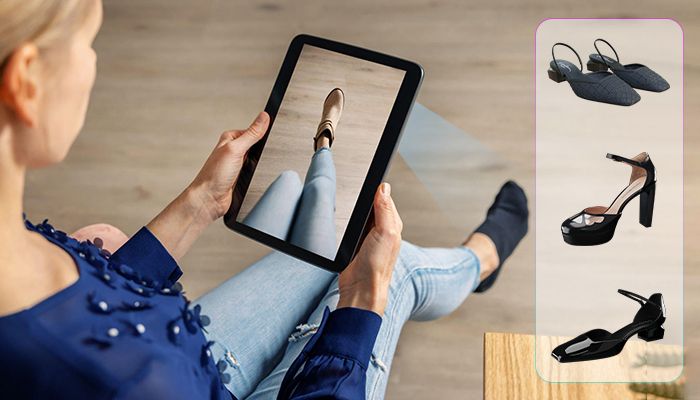The landscape of e-commerce is in a constant state of evolution, driven by technology and changing consumer preferences. In recent years, one groundbreaking innovation has been making significant waves in the industry—Virtual Try-Ons (VTO). This revolutionary technology is changing how consumers shop online, offering an interactive and immersive experience.
As we focus on whether Virtual Try-Ons are the future of E-commerce business, we will explore how custom 3D modeling services use cutting-edge technology to shape online retail's future, the key advantages it brings to businesses and consumers, and the exciting possibilities it holds for a more engaging and personalized shopping journey.
Let us save time and explore the transformative potential of Virtual Try-Ons in e-commerce.
What exactly is a virtual try-on?
Virtual Try-On (VTO) is a technology that allows consumers to digitally try on products, such as clothing, accessories, eyewear, makeup, and even furniture, without physically touching or wearing them. When it comes to technology, VTO uses augmented reality (AR) or virtual reality (VR) technologies to provide users with a realistic simulation of how a product will look or fit on them or in their environment.
Fact: Around 12% of U.S. consumers prefer virtual try-ons before making a purchase
Getting the correct set of accessories is a crucial factor when purchasing products. VTO offers the best solution.
Tech challenge behind Virtual try-on

When it comes to implementing VTO for your products, there are numerous challenges behind it. But, with the challenge comes a solution; as a result, brands are seamlessly integrating technology for comprehensive solutions.
Realistic Visualization
Creating and maintaining high-quality 3D models of products can be resource-intensive.
It's best to employ advanced 3D modeling techniques and tools to ensure accurate and detailed virtual representations of products. You may always collaborate with 3D modeling experts or use automated software for product digitization.
Device Compatibility
Ensuring compatibility with various devices (smartphones, tablets, desktops, VR headsets) can be complex.
Develop VTO applications with cross-platform compatibility using technologies like WebGL or WebXR. You can implement responsive design principles to adapt to different screen sizes.
Data Security and Privacy
Handling user data, such as images and measurements, while ensuring data privacy and security.
The experts will implement strong data encryption and user consent mechanisms. Complying with data protection regulations (e.g., GDPR) and communicating your data handling practices to users is noteworthy in this scenario.
Augmented Reality (AR) and Virtual Reality (VR)

Choosing the right technology for VTO based on product type and user experience preferences.
You must conduct thorough user research and consider the product's nature and target audience to determine whether AR or VR VTO is more appropriate.
Top brands that utilize VTO solution
Ray-Ban (Eyewear)
Ray-Ban offers a Virtual Try-On feature on its website that enables users to try on a selection of Ray-Ban sunglasses using their webcam or smartphone camera.
Gucci (Fashion)
Gucci implemented a Virtual Try-On feature for its eyewear collection, allowing users to see how different Gucci sunglasses and optical frames will look on their faces using augmented reality.
L'Oreal (Cosmetics)
L'Oreal's AR-powered app, "Virtual Try On," lets users try on a wide range of cosmetics products, experiment with makeup looks, and virtually test different lipstick shades, eyeshadow, and more.
Adidas (Footwear)
Adidas offers a "Try On" feature on its website that uses augmented reality to allow users to try on sneakers virtually. Customers can see how the shoes will look on their feet and adjust for size and style.
Conclusion
VTO offers the solution to the inability to physically interact with products before purchasing. With the integration of AR and VR, businesses can now bridge the gap and deliver an interactive and immersive shopping experience. Over time, virtual technology is expected to evolve further. Moreover, it can redefine how consumers go for a purchase.
FAQs
What is Virtual Try-on technology?
Virtual Try-On technology utilizes 3D mapping to interact with products like clothing, accessories, and cosmetics. Consumers can explore how they would look or fit before making a purchase.
What are the benefits of Virtual Try-ons?

Virtual Try-Ons enhance the online shopping experience by reducing uncertainty, increasing user confidence, and diminishing returns while offering a more interactive and personalized way to visualize products before purchase. It streamlines decision-making, drives customer engagement, and empowers businesses to flourish in the competitive e-commerce landscape.
Can virtual try-ons increase sales?
Yes, Virtual Try-Ons increase sales by reducing purchase hesitation. Consumers can access a more interactive and personalized shopping experience, ultimately driving business conversions and revenue growth.
What is the future of Virtual reality for ecommerce businesses?
For e-commerce businesses, VR holds the potential for an immersive virtual shopping environment. It's a significant way to enhance sales. As VR technology advances, consumers can have realistic access to products. This minimizes the chances of product returns.






